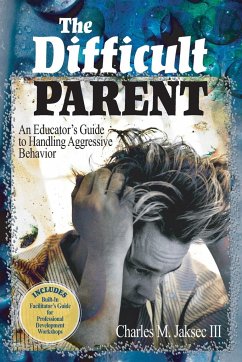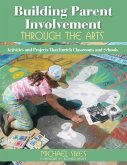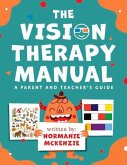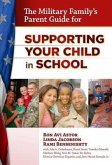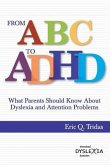- Broschiertes Buch
- Merkliste
- Auf die Merkliste
- Bewerten Bewerten
- Teilen
- Produkt teilen
- Produkterinnerung
- Produkterinnerung
In this resource with a built-in facilitator's guide, Jaksec digs deeply into the problem of parental aggression, specifying strategies for a broad audience of educators using the effective RAID approach.
Andere Kunden interessierten sich auch für
![Building Parent Involvement Through the Arts Building Parent Involvement Through the Arts]() Michael SikesBuilding Parent Involvement Through the Arts37,99 €
Michael SikesBuilding Parent Involvement Through the Arts37,99 €![What Every Parent Should Know About Schools, Standards, and High Stakes Tests What Every Parent Should Know About Schools, Standards, and High Stakes Tests]() Donna Walker TilestonWhat Every Parent Should Know About Schools, Standards, and High Stakes Tests17,99 €
Donna Walker TilestonWhat Every Parent Should Know About Schools, Standards, and High Stakes Tests17,99 €![Powerful Parent Letters for K-3 Powerful Parent Letters for K-3]() Mary Anne DugganPowerful Parent Letters for K-337,99 €
Mary Anne DugganPowerful Parent Letters for K-337,99 €![The Vision Therapy Manual: A Parent and Teacher's Guide The Vision Therapy Manual: A Parent and Teacher's Guide]() Normanie McKenzieThe Vision Therapy Manual: A Parent and Teacher's Guide57,99 €
Normanie McKenzieThe Vision Therapy Manual: A Parent and Teacher's Guide57,99 €![The Signing Family: What Every Parent Should Know about Sign Communication The Signing Family: What Every Parent Should Know about Sign Communication]() David StewartThe Signing Family: What Every Parent Should Know about Sign Communication24,99 €
David StewartThe Signing Family: What Every Parent Should Know about Sign Communication24,99 €![The Military Family's Parent Guide for Supporting Your Child in School The Military Family's Parent Guide for Supporting Your Child in School]() Ron Avi AstorThe Military Family's Parent Guide for Supporting Your Child in School28,99 €
Ron Avi AstorThe Military Family's Parent Guide for Supporting Your Child in School28,99 €![From ABC to ADHD: What Every Parent Should Know About Dyslexia and Attention Problems From ABC to ADHD: What Every Parent Should Know About Dyslexia and Attention Problems]() Eric Q. TridasFrom ABC to ADHD: What Every Parent Should Know About Dyslexia and Attention Problems35,99 €
Eric Q. TridasFrom ABC to ADHD: What Every Parent Should Know About Dyslexia and Attention Problems35,99 €-
-
-
In this resource with a built-in facilitator's guide, Jaksec digs deeply into the problem of parental aggression, specifying strategies for a broad audience of educators using the effective RAID approach.
Hinweis: Dieser Artikel kann nur an eine deutsche Lieferadresse ausgeliefert werden.
Hinweis: Dieser Artikel kann nur an eine deutsche Lieferadresse ausgeliefert werden.
Produktdetails
- Produktdetails
- Verlag: Corwin
- Seitenzahl: 168
- Erscheinungstermin: 21. Juni 2004
- Englisch
- Abmessung: 229mm x 152mm x 9mm
- Gewicht: 254g
- ISBN-13: 9780761988991
- ISBN-10: 0761988998
- Artikelnr.: 21656428
- Herstellerkennzeichnung
- Libri GmbH
- Europaallee 1
- 36244 Bad Hersfeld
- gpsr@libri.de
- Verlag: Corwin
- Seitenzahl: 168
- Erscheinungstermin: 21. Juni 2004
- Englisch
- Abmessung: 229mm x 152mm x 9mm
- Gewicht: 254g
- ISBN-13: 9780761988991
- ISBN-10: 0761988998
- Artikelnr.: 21656428
- Herstellerkennzeichnung
- Libri GmbH
- Europaallee 1
- 36244 Bad Hersfeld
- gpsr@libri.de
Charles M. Jaksec III has served as a school social worker in The Hillsborough County School District for 21 years and has been a member of the district's crisis intervention team for 18 years. He serves as the chairperson of the district's Bullying Committee and is a member of the district's Violence Prevention Committee. Jaksec is the author of The Difficult Parent: An Educator's Guide to Handling Aggressive Behaviors (Corwin Press 2004) and The Confrontational Parent: A Practical Guide for School Leaders (Eye On Education, Inc. 2003). He speaks nationally and locally on the topics of school crisis intervention and parental aggression. Jaksec has a master's degree in counseling services from Slippery Rock University, and an educational specialist degree in counselor education and a doctorate in curriculum and instruction from the University of South Florida.
Acknowledgements About the Author Introduction Part I: Parental Aggression Towards School Personnel 1. A Genuine Concern for School Personnel Are Confrontational Parents a Pertinent Issue? How Often Does Parental Aggression Occur? Do Employees Have to Tolerate Parental Aggression? Could Parental Aggression Affect Me? Why Does the Topic of Parental Aggression Seem Obscure? What Makes Parental Aggression a Unique Issue? Questions for Discussion 2. The Reactive Nature of Education The Effects of Reactivity Is a Proactive Approach Necessary? Why Does This Feel Funny? Why Do Parents Become Hostile? Questions for Discussion 3. Confrontational Parents and Your Colleagues School Administrators Teachers Guidance Counselors School Social Workers School Health Personnel Office Personnel School Psychologists Other School Personnel Questions for Discussion Part II: An Approach to Address Parental Aggression 4. The RAID Approach What Have We Established So Far? Seven Frequently Asked Questions Regarding the RAID Approach Just Common Sense A Schoolwide Approach to Parental Aggression Brevity and Simplicity Questions for Discussion 5. RAID Step One: Recognizing the Potential for a Volatile Encounter To Meet or Not to Meet When is it Too Risky to Meet With a Parent? How Do You Say No? The "Guilts" Step One in Motion Step One Summary Step One Checklist Questions for Discussion 6. RAID Step Two: Assessing Your Ability to Emotionally Handle the Situation What Types of Issues Affect Our Emotions and Disposition? Face Number Four Early-Warning Colleagues "I
ll be Back" Step Two Summary Step Two Checklist Questions for Discussion 7. RAID Step Three: Identifying Your Advantages Advantages: What
s Available? Workforce Advantages Environmental Advantages Step Three Summary Step Three Checklist Questions for Discussion 8. RAID Step Four: Diffusing Anger During the Initial Approach and Greeting Observing the Parent Approaching the Parent Greeting the Parent Setting Parameters Step Four Summary Step Four Checklist Questions for Discussion 9. Putting the RAID Approach to Work Case #1: Mrs. Winslow Case #2: Mrs. Cananski Summary Questions for Discussion Part III: Issues, Questions, and Installation 10. The Worst-Case Scenario ... and After After the Confrontation I Gotta Unload: The Importance of Debriefing Summary Questions for Discussion 11. Four Great Questions What If a Parent Becomes Aggressive and a Student Is in the Vicinity? What If a Parent Confronts a Staff Member Off Campus? Which Staff Member Plays the Most Important Role in the RAID Approach? How Do You Handle a Parent When He or She Returns to the School? Questions for Discussion Resource A: Traumatic Stress Reactions Questionnaire References Facilitator
s Guide Who Should Use This Guide? Who Should Receive a "RAID Approach" In-Service? When Should The RAID Approach Be Installed? How This Guide Is Organized What Materials Are Necessary? Materials for Facilitators Materials for Participants Module One Task One: Introduce the Issue of Parental Aggression Task Two: Identification of Previous Staff Interactions With Aggressive Parents Task Three: Identify the Possible Effects of Parental Aggression on School Personnel Task Four: Establish the Value of a Multidisciplinary Approach to Parental Aggression Module Two Task One: Introduce the RAID Approach Task Two: Explain Step One: Recognizing the Potential for a Volatile Encounter Task Three: Explain Step Two: Assessing Your Ability to Emotionally Handle the Situation Task Four: Explain Step Three: Identifying Your Advantages Task Five: Explain Step Four: Diffusing Parent Anger During the Initial Approach and Greeting Module Three Task One: Solicit Feedback Regarding the RAID Approach Task Two: Identify Roles and Responsibilities Task Three: Discuss Worst-Case Scenarios Task Four: Establish a Debriefing Mechanism Overhead #1 Overhead #2 Overhead #3 Overhead #4 Overhead #5 Overhead #6 Overhead #7 Overhead #8 Overhead #9 Index
ll be Back" Step Two Summary Step Two Checklist Questions for Discussion 7. RAID Step Three: Identifying Your Advantages Advantages: What
s Available? Workforce Advantages Environmental Advantages Step Three Summary Step Three Checklist Questions for Discussion 8. RAID Step Four: Diffusing Anger During the Initial Approach and Greeting Observing the Parent Approaching the Parent Greeting the Parent Setting Parameters Step Four Summary Step Four Checklist Questions for Discussion 9. Putting the RAID Approach to Work Case #1: Mrs. Winslow Case #2: Mrs. Cananski Summary Questions for Discussion Part III: Issues, Questions, and Installation 10. The Worst-Case Scenario ... and After After the Confrontation I Gotta Unload: The Importance of Debriefing Summary Questions for Discussion 11. Four Great Questions What If a Parent Becomes Aggressive and a Student Is in the Vicinity? What If a Parent Confronts a Staff Member Off Campus? Which Staff Member Plays the Most Important Role in the RAID Approach? How Do You Handle a Parent When He or She Returns to the School? Questions for Discussion Resource A: Traumatic Stress Reactions Questionnaire References Facilitator
s Guide Who Should Use This Guide? Who Should Receive a "RAID Approach" In-Service? When Should The RAID Approach Be Installed? How This Guide Is Organized What Materials Are Necessary? Materials for Facilitators Materials for Participants Module One Task One: Introduce the Issue of Parental Aggression Task Two: Identification of Previous Staff Interactions With Aggressive Parents Task Three: Identify the Possible Effects of Parental Aggression on School Personnel Task Four: Establish the Value of a Multidisciplinary Approach to Parental Aggression Module Two Task One: Introduce the RAID Approach Task Two: Explain Step One: Recognizing the Potential for a Volatile Encounter Task Three: Explain Step Two: Assessing Your Ability to Emotionally Handle the Situation Task Four: Explain Step Three: Identifying Your Advantages Task Five: Explain Step Four: Diffusing Parent Anger During the Initial Approach and Greeting Module Three Task One: Solicit Feedback Regarding the RAID Approach Task Two: Identify Roles and Responsibilities Task Three: Discuss Worst-Case Scenarios Task Four: Establish a Debriefing Mechanism Overhead #1 Overhead #2 Overhead #3 Overhead #4 Overhead #5 Overhead #6 Overhead #7 Overhead #8 Overhead #9 Index
Acknowledgements About the Author Introduction Part I: Parental Aggression Towards School Personnel 1. A Genuine Concern for School Personnel Are Confrontational Parents a Pertinent Issue? How Often Does Parental Aggression Occur? Do Employees Have to Tolerate Parental Aggression? Could Parental Aggression Affect Me? Why Does the Topic of Parental Aggression Seem Obscure? What Makes Parental Aggression a Unique Issue? Questions for Discussion 2. The Reactive Nature of Education The Effects of Reactivity Is a Proactive Approach Necessary? Why Does This Feel Funny? Why Do Parents Become Hostile? Questions for Discussion 3. Confrontational Parents and Your Colleagues School Administrators Teachers Guidance Counselors School Social Workers School Health Personnel Office Personnel School Psychologists Other School Personnel Questions for Discussion Part II: An Approach to Address Parental Aggression 4. The RAID Approach What Have We Established So Far? Seven Frequently Asked Questions Regarding the RAID Approach Just Common Sense A Schoolwide Approach to Parental Aggression Brevity and Simplicity Questions for Discussion 5. RAID Step One: Recognizing the Potential for a Volatile Encounter To Meet or Not to Meet When is it Too Risky to Meet With a Parent? How Do You Say No? The "Guilts" Step One in Motion Step One Summary Step One Checklist Questions for Discussion 6. RAID Step Two: Assessing Your Ability to Emotionally Handle the Situation What Types of Issues Affect Our Emotions and Disposition? Face Number Four Early-Warning Colleagues "I
ll be Back" Step Two Summary Step Two Checklist Questions for Discussion 7. RAID Step Three: Identifying Your Advantages Advantages: What
s Available? Workforce Advantages Environmental Advantages Step Three Summary Step Three Checklist Questions for Discussion 8. RAID Step Four: Diffusing Anger During the Initial Approach and Greeting Observing the Parent Approaching the Parent Greeting the Parent Setting Parameters Step Four Summary Step Four Checklist Questions for Discussion 9. Putting the RAID Approach to Work Case #1: Mrs. Winslow Case #2: Mrs. Cananski Summary Questions for Discussion Part III: Issues, Questions, and Installation 10. The Worst-Case Scenario ... and After After the Confrontation I Gotta Unload: The Importance of Debriefing Summary Questions for Discussion 11. Four Great Questions What If a Parent Becomes Aggressive and a Student Is in the Vicinity? What If a Parent Confronts a Staff Member Off Campus? Which Staff Member Plays the Most Important Role in the RAID Approach? How Do You Handle a Parent When He or She Returns to the School? Questions for Discussion Resource A: Traumatic Stress Reactions Questionnaire References Facilitator
s Guide Who Should Use This Guide? Who Should Receive a "RAID Approach" In-Service? When Should The RAID Approach Be Installed? How This Guide Is Organized What Materials Are Necessary? Materials for Facilitators Materials for Participants Module One Task One: Introduce the Issue of Parental Aggression Task Two: Identification of Previous Staff Interactions With Aggressive Parents Task Three: Identify the Possible Effects of Parental Aggression on School Personnel Task Four: Establish the Value of a Multidisciplinary Approach to Parental Aggression Module Two Task One: Introduce the RAID Approach Task Two: Explain Step One: Recognizing the Potential for a Volatile Encounter Task Three: Explain Step Two: Assessing Your Ability to Emotionally Handle the Situation Task Four: Explain Step Three: Identifying Your Advantages Task Five: Explain Step Four: Diffusing Parent Anger During the Initial Approach and Greeting Module Three Task One: Solicit Feedback Regarding the RAID Approach Task Two: Identify Roles and Responsibilities Task Three: Discuss Worst-Case Scenarios Task Four: Establish a Debriefing Mechanism Overhead #1 Overhead #2 Overhead #3 Overhead #4 Overhead #5 Overhead #6 Overhead #7 Overhead #8 Overhead #9 Index
ll be Back" Step Two Summary Step Two Checklist Questions for Discussion 7. RAID Step Three: Identifying Your Advantages Advantages: What
s Available? Workforce Advantages Environmental Advantages Step Three Summary Step Three Checklist Questions for Discussion 8. RAID Step Four: Diffusing Anger During the Initial Approach and Greeting Observing the Parent Approaching the Parent Greeting the Parent Setting Parameters Step Four Summary Step Four Checklist Questions for Discussion 9. Putting the RAID Approach to Work Case #1: Mrs. Winslow Case #2: Mrs. Cananski Summary Questions for Discussion Part III: Issues, Questions, and Installation 10. The Worst-Case Scenario ... and After After the Confrontation I Gotta Unload: The Importance of Debriefing Summary Questions for Discussion 11. Four Great Questions What If a Parent Becomes Aggressive and a Student Is in the Vicinity? What If a Parent Confronts a Staff Member Off Campus? Which Staff Member Plays the Most Important Role in the RAID Approach? How Do You Handle a Parent When He or She Returns to the School? Questions for Discussion Resource A: Traumatic Stress Reactions Questionnaire References Facilitator
s Guide Who Should Use This Guide? Who Should Receive a "RAID Approach" In-Service? When Should The RAID Approach Be Installed? How This Guide Is Organized What Materials Are Necessary? Materials for Facilitators Materials for Participants Module One Task One: Introduce the Issue of Parental Aggression Task Two: Identification of Previous Staff Interactions With Aggressive Parents Task Three: Identify the Possible Effects of Parental Aggression on School Personnel Task Four: Establish the Value of a Multidisciplinary Approach to Parental Aggression Module Two Task One: Introduce the RAID Approach Task Two: Explain Step One: Recognizing the Potential for a Volatile Encounter Task Three: Explain Step Two: Assessing Your Ability to Emotionally Handle the Situation Task Four: Explain Step Three: Identifying Your Advantages Task Five: Explain Step Four: Diffusing Parent Anger During the Initial Approach and Greeting Module Three Task One: Solicit Feedback Regarding the RAID Approach Task Two: Identify Roles and Responsibilities Task Three: Discuss Worst-Case Scenarios Task Four: Establish a Debriefing Mechanism Overhead #1 Overhead #2 Overhead #3 Overhead #4 Overhead #5 Overhead #6 Overhead #7 Overhead #8 Overhead #9 Index

